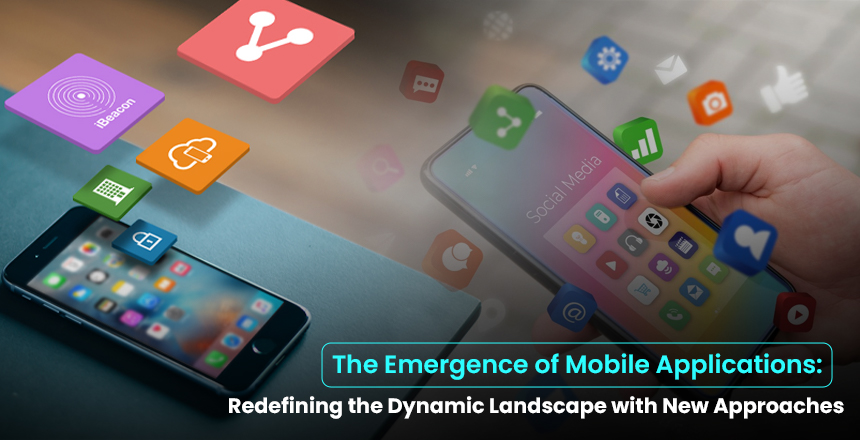The digital world has gone through a lot of change over the last few years, mostly fueled by the
need for mobile applications. Now, these applications can hardly be imagined without using
which users receive information, communicate, and perform various functions in just a few
clicks. This article is devoted to the topic of mobile applications and their techniques, and the
author includes five examples of using such applications to explain the possible consequences
to reveal the significance of the innovations.
Smartphone applications have continued to provide an opportunity to different companies to
keep on reaching out to the targeted consumers/audiences/Users and, more importantly, have
revolutionized the way people look at and/or engage with technology. It is important to point out
that these applications are available for any interest and need, as they can serve as social
networks or entertainment platforms, or even business tools such as productivity apps or
e-shopper applications. This article brings out the importance of mobile applications in our
everyday lives, the
Topic: Strategies in the Development of Mobile Applications.
Mobile applications have become part of the new generation, and their discovery and
penetration into people’s lives have changed the face of business. So there is already this
evolution into a mobile-first world happening, and it is being seen by those on the field, so
companies should do things creatively when making the mobile apps. These strategies can be
broadly classified into the following categories:
- User-Centric Design: The features that business entities are developing are now more
inclined to design and build products and services that make them more usable. This involves
having to consider the type of customers to expect and creating the app in such a way that they
will appreciate it. An excellent example of this is, for instance, the interface of Instagram, which,
at first sight and without any complex commands, has won the hearts of millions of users.
- Cloud Integration: Telecommunications solutions are now one of the biggest pieces of the
mobile application development mosaic. It also allows developers to create the type of
application that can be reused, extended, and maintained in the future with ease. Forces such
as Dropbox have somewhere employed this strategy by ensuring that users have a secure
place where they can store and manage all their files on various devices.
- Personalization: Personalization remains one of the most effective strategies for increasing both users’ attention and their loyalty. Using M-Apps as a way of interacting with users, there is a possibility of creating new forms of engagement with an individual, especially if the given application is tailored to deliver more unique content or options. Such functionality can be developed with the help of published algorithms and more specific machine learning approaches that can determine the user preferences. One great example is when companies such as Netflix bring out a recommendation system that helps users see what they will want simply based on the past acts that these people have done in their activities on the platform.
- Cross-Platform Compatibility: The creation of applications for several operating systems,
including iOS and Android systems, requires much time and effort. To tackle this problem,
developers are now using other techniques known as cross-platform tools that allow them to
build applications that are in harmony with the different devices. Xamarin, an integrated
development environment instrument, enables the developers to use C# and build the
application that operates with iOS and Android.
- Security and Privacy: As the number of threats of data violation and privacy continues to rise,
companies should come up with ways of enhancing the security and privacy of their mobile
applications. This includes encryption, strong authentication, and always updating of the app in
order to protect against any potential created risk. For example, Apple’s HealthKit is a good
example of an app that keeps that level of privacy because it is working with your health
information.
Testimonials
- Elizabeth – Freelance Photographer: To promote her work, Elizabeth uses Instagram as her
main platform with which she markets herself to potential clients. The current features are highly
responsive, she says, which has made the app her preferred choice of platform when it comes
to branding her app. She loves to share quality pictures and cheer up our fans through
comments and messages.
- Michael – Entrepreneur: Michael’s e-commerce primarily depends on the sales of mobile
applications. Managing to integrate his business with the cloud and adopt personalization
techniques of business, he has managed to cultivate connoisseur clients and expand his market
share. It has also ensured that the customers who interact with his app have placed a lot of trust
in the shown payment possibilities.
- Sarah – Travel Enthusiast: Sarah gave an example of Airbnb and TripAdvisor, saying that
travel has become better because mobile applications are useful at particular times. Let’s just
name some of the apps that help her when she wants to plan her travel, like finding a place to
stay for her few, like to see in an affordable hotel or apartment, food, which includes the
restaurant or even a food delivery app where she can taste her local delicacy, and some other
activities that she must see, such as one that can tell her places to visit that are interesting.
- Mark – Productivity Guru: Mark is another individual who loves and/or needs to make
productivity a trend, hence using applications such as Evernote and Trello, among others, to
sort his day-to-day tasks as well as his work-related projects. These apps have greatly
enhanced his productivity and organization, schedule, and focus towards his agenda. The
features that he finds most valuable are the ability to have these apps work across multiple
platforms and the synchronization of the data he put in across his gadgets.
- Laura – Fitness Enthusiast: Thanks to mobile applications such as MyFitnessPal, a ready-to-use tool, and Strava for tracking Laura’s exercise routine, mobile applications have made it easy for Laura to achieve her fitness goals. Some of these apps have offered her workout routines, dietitian advice, and even monitoring the progress in real time. Using thes mobile apps, Laura found the support, and this has assisted her to further progress to making changes with her lifestyle.
Conclusion
Hence it can be said that mobile applications are a part of the lives of people, and with the
impact they have brought, there have been changes in the use of technology in modern society.
The measures covered in this piece, including user-focused design, cloud adoption,
customization, omnichannel compatibility, and security and privacy, have been important in the
growth of these revolutionary apps. The testimonials presented in the case allow a glimpse at
how these applications affect users and what value they introduce into our lives. In light of the
changes, these approaches and the development of mobile applications.








